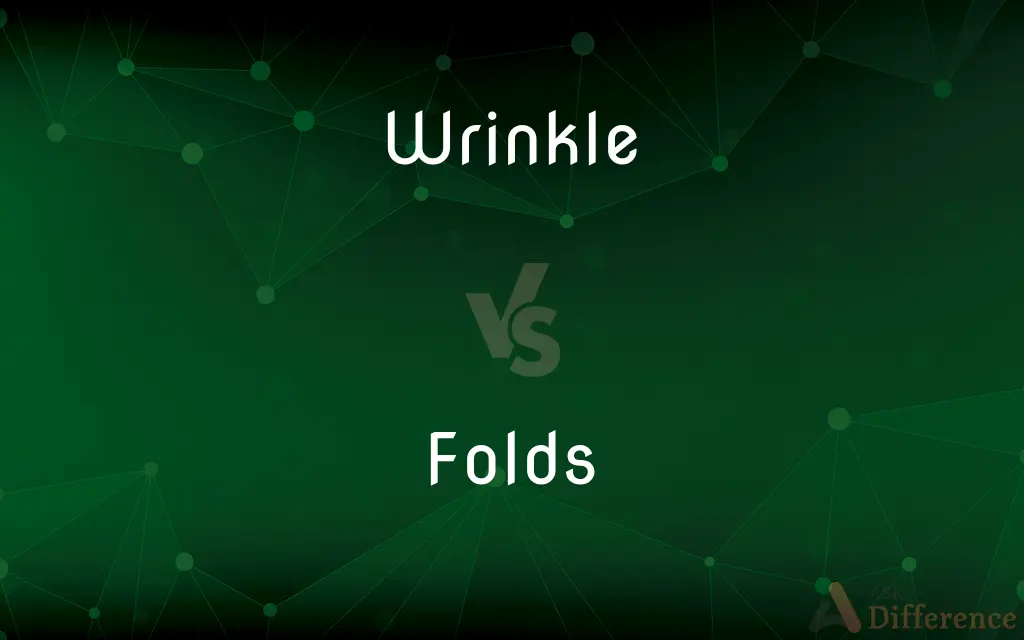Wrinkle vs. Folds — What's the Difference?
By Maham Liaqat & Urooj Arif — Published on October 25, 2024
Wrinkles are small lines or creases in the skin, often resulting from aging or facial expressions, while folds are bends or creases in materials or surfaces, indicating a broader range of contexts.

Difference Between Wrinkle and Folds
Table of Contents
ADVERTISEMENT
Key Differences
Wrinkles primarily appear on the skin due to aging, sun exposure, and facial expressions. These fine lines or creases signify changes in the skin's elasticity and collagen production. On the other hand, folds can occur in various materials like fabric, paper, or even skin, representing a deliberate or natural bending that creates a crease or overlap.
Wrinkles are often associated with a natural process of aging or external factors affecting the skin, leading to a loss of elasticity and moisture. Whereas folds may be intentional, as in clothing design, or natural, such as the folds of the skin, indicating a more versatile term not limited to aging or skin health.
In terms of treatment or management, wrinkles might be addressed with skincare products, medical treatments like Botox, or lifestyle changes to slow their formation. Folds, however, might be desirable in certain contexts (e.g., fashion) or managed through physical alteration of the material (ironing, pressing) or surgery in the case of bodily folds.
The perception of wrinkles tends to be more negative, often associated with loss of youthfulness and vitality. Meanwhile, folds can be neutral or even positive, depending on their context, such as the aesthetics of folded fabrics or the functionality of folded designs.
Regarding their formation, wrinkles develop gradually over time and are influenced by various internal and external factors. Folds, however, can form instantly through action (folding a piece of paper) or over time due to natural body movements, showing a distinction in the dynamics of their creation.
ADVERTISEMENT
Comparison Chart
Definition
Lines or creases on the skin
Bends or creases in materials or surfaces
Causes
Aging, facial expressions, sun exposure
Bending or creasing, intentional or natural
Contexts
Primarily skin, especially facial
Skin, fabric, paper, etc.
Perceptions
Often negative (aging, loss of youth)
Neutral or positive, depending on context
Management
Skincare, medical treatments, lifestyle changes
Ironing, pressing, surgery (for skin folds)
Compare with Definitions
Wrinkle
A sign of skin losing its elasticity.
Using moisturizer helps reduce the appearance of wrinkles.
Folds
A bend or crease in a material.
The folds in the curtain added to its elegance.
Wrinkle
Often associated with aging or sun damage.
Sunscreen can help prevent wrinkles caused by sun exposure.
Folds
Natural or intentional bending creating layers.
The folds of the dress were carefully designed.
Wrinkle
Small folds in the skin caused by facial expressions.
Laugh lines are wrinkles that appear from smiling.
Folds
A method to compact or store materials efficiently.
Folding clothes saves space in drawers.
Wrinkle
Lines or creases in the skin due to aging.
She noticed more wrinkles around her eyes as she aged.
Folds
Can occur in skin as part of its natural texture.
The folds of the skin can deepen with age.
Wrinkle
Can be minimized with cosmetic treatments.
Botox injections smooth out wrinkles temporarily.
Folds
Utilized in design for functionality or aesthetics.
The architect incorporated folds into the building's facade for visual interest.
Wrinkle
A small furrow, ridge, or crease on a normally smooth surface, caused by crumpling, folding, or shrinking.
Folds
To bend over or double up so that one part lies on another part
Fold a sheet of paper.
Wrinkle
A line or crease in the skin, as from age.
Folds
To bring from a compact to an extended position; unfold
Folded the ironing board down from the wall.
Folded out the map to see where we were.
Wrinkle
To contract into furrows and prominences; to make a wrinkle or wrinkles in; to corrugate; as, wrinkle the skin or the brow.
Her wrinkled form in black and white arrayed.
Folds
The act or an instance of folding.
Wrinkle
A slight depression in the smoothness of a surface;
His face has many lines
Ironing gets rid of most wrinkles
Folds
A line or mark made by folding; a crease
Tore the paper carefully along the fold.
A headline that appeared above the fold.
Wrinkle
Become wrinkled or crumpled or creased;
This fabric won't wrinkle
Folds
Plural of fold
Common Curiosities
Can folds be desirable?
Yes, in certain contexts like fashion and design, folds are aesthetically valuable.
What causes wrinkles?
Aging, facial expressions, and sun exposure.
How are wrinkles treated?
Through skincare routines, medical treatments like Botox, and lifestyle adjustments.
Can wrinkles be prevented?
To some extent, with sun protection, skincare, and healthy lifestyle choices.
Are all folds in the skin considered wrinkles?
No, folds can be broader and are not solely related to aging or skin damage.
Can folds be intentionally created?
Yes, in design and art, folds are often created for functional or aesthetic reasons.
Is ironing a way to manage folds?
Yes, in fabrics, ironing can remove unwanted folds.
What differentiates a wrinkle from a fold?
Wrinkles are specific to skin aging and expressions, while folds can occur in various materials and contexts.
Do wrinkles only appear on the face?
No, they can appear on any part of the skin but are most noticeable on the face.
Are wrinkles always unwanted?
Mostly, though some view them as a sign of wisdom or life experience.
Can lifestyle affect the development of wrinkles?
Yes, lifestyle choices like diet, smoking, and sun exposure have significant impacts.
What materials commonly exhibit folds?
Fabrics, paper, and skin are common examples.
Is there a difference in how wrinkles and folds are perceived culturally?
Yes, wrinkles are often seen negatively as signs of aging, whereas folds can be neutral or positive.
Can both wrinkles and folds be natural?
Yes, both can develop naturally due to aging, movement, or the inherent properties of materials.
Are there any similarities between wrinkles and folds?
Both involve the bending or creasing of a surface but differ in their causes, contexts, and perceptions.
Share Your Discovery

Previous Comparison
Type I Error vs. Type II Error
Next Comparison
Social Cognitive Theory vs. BehaviorismAuthor Spotlight
Written by
Maham LiaqatCo-written by
Urooj ArifUrooj is a skilled content writer at Ask Difference, known for her exceptional ability to simplify complex topics into engaging and informative content. With a passion for research and a flair for clear, concise writing, she consistently delivers articles that resonate with our diverse audience.










































